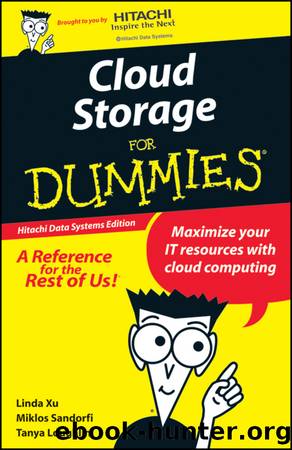Cloud Storage For Dummies (Custom) by Linda Xu

Author:Linda Xu
Language: eng
Format: epub
Publisher: John Wiley & Sons, Ltd.
Published: 2010-09-14T00:00:00+00:00
Chapter 4
Best Practices and Use Cases
In This Chapter
Phasing in the use of cloud
Improving savings and operational efficiencies
Assessing what to move to cloud
Adding business value
To date, adoption of cloud by enterprise organizations is seen predominantly in the private cloud space. Over time, the assumption is that enterprise organizations will garner more confidence in the maturity of external cloud offerings and security through trusted partners.
Enterprise organizations may best capitalize on the cost advantages of cloud computing while protecting data, by moving in phases from private to hybrid and eventually to public models over time. This chapter talks about how these practices can help organizations enter the cloud environment safely and cost-effectively to quickly begin seizing operational cost reductions.
Adopting Cloud at Your Own Pace
A good general rule is to adopt cloud based on business needs. By deploying private cloud, enterprise organizations can forgo painful and expensive forklift changes and leverage existing investments.
In this phased approach, organizations can realize incremental improvements and cost reductions by first adopting private cloud, and gaining a more thorough understanding of how to deploy and utilize cloud services within the safety of the data center. Then, the business is able to make better decisions about what data and applications to deploy through a trusted partner and eventually within a public cloud.
Moving from Peripheral to Core Data
Start by identifying data that may have lower business value and less stringent service level agreement (SLA) requisites, such as âTier 3â data types, including stale, unstructured content residing in home directory or file shares, or static content such as backup or archive data.
By starting with the peripheral data types (Tier 3 as shown in Figure 4-1), organizations are able to free up both storage resources and staff to focus on the business-critical, core applications. This allows organizations to improve operational efficiency and utilization, reduce costs and gain experience and best practices, so they can move towards the core applications at their own pace.
Download
This site does not store any files on its server. We only index and link to content provided by other sites. Please contact the content providers to delete copyright contents if any and email us, we'll remove relevant links or contents immediately.
Sass and Compass in Action by Wynn Netherland Nathan Weizenbaum Chris Eppstein Brandon Mathis(7440)
Grails in Action by Glen Smith Peter Ledbrook(7332)
Kotlin in Action by Dmitry Jemerov(4683)
Management Strategies for the Cloud Revolution: How Cloud Computing Is Transforming Business and Why You Can't Afford to Be Left Behind by Charles Babcock(4158)
The Age of Surveillance Capitalism by Shoshana Zuboff(3466)
Learn Windows PowerShell in a Month of Lunches by Don Jones(3277)
Mastering Azure Security by Mustafa Toroman and Tom Janetscheck(3051)
Mastering Python for Networking and Security by José Manuel Ortega(3004)
Blockchain Basics by Daniel Drescher(2928)
Microsoft 365 Identity and Services Exam Guide MS-100 by Aaron Guilmette(2887)
Configuring Windows Server Hybrid Advanced Services Exam Ref AZ-801 by Chris Gill(2864)
Azure Containers Explained by Wesley Haakman & Richard Hooper(2757)
TCP IP by Todd Lammle(2672)
From CIA to APT: An Introduction to Cyber Security by Edward G. Amoroso & Matthew E. Amoroso(2511)
Hands-On Azure for Developers by Kamil Mrzyglod(2468)
Combating Crime on the Dark Web by Nearchos Nearchou(2461)
React Native - Building Mobile Apps with JavaScript by Novick Vladimir(2361)
The Social Psychology of Inequality by Unknown(2346)
MCSA Windows Server 2016 Study Guide: Exam 70-740 by William Panek(2330)
